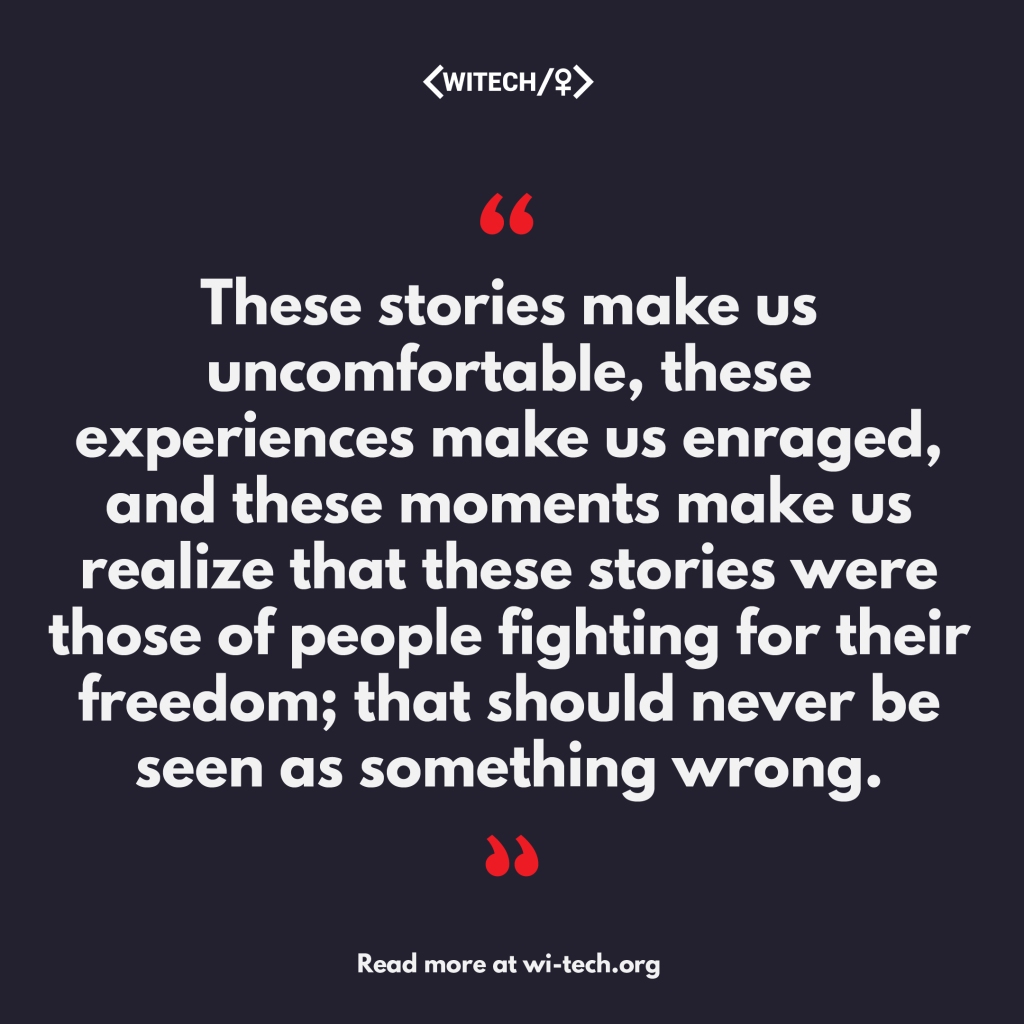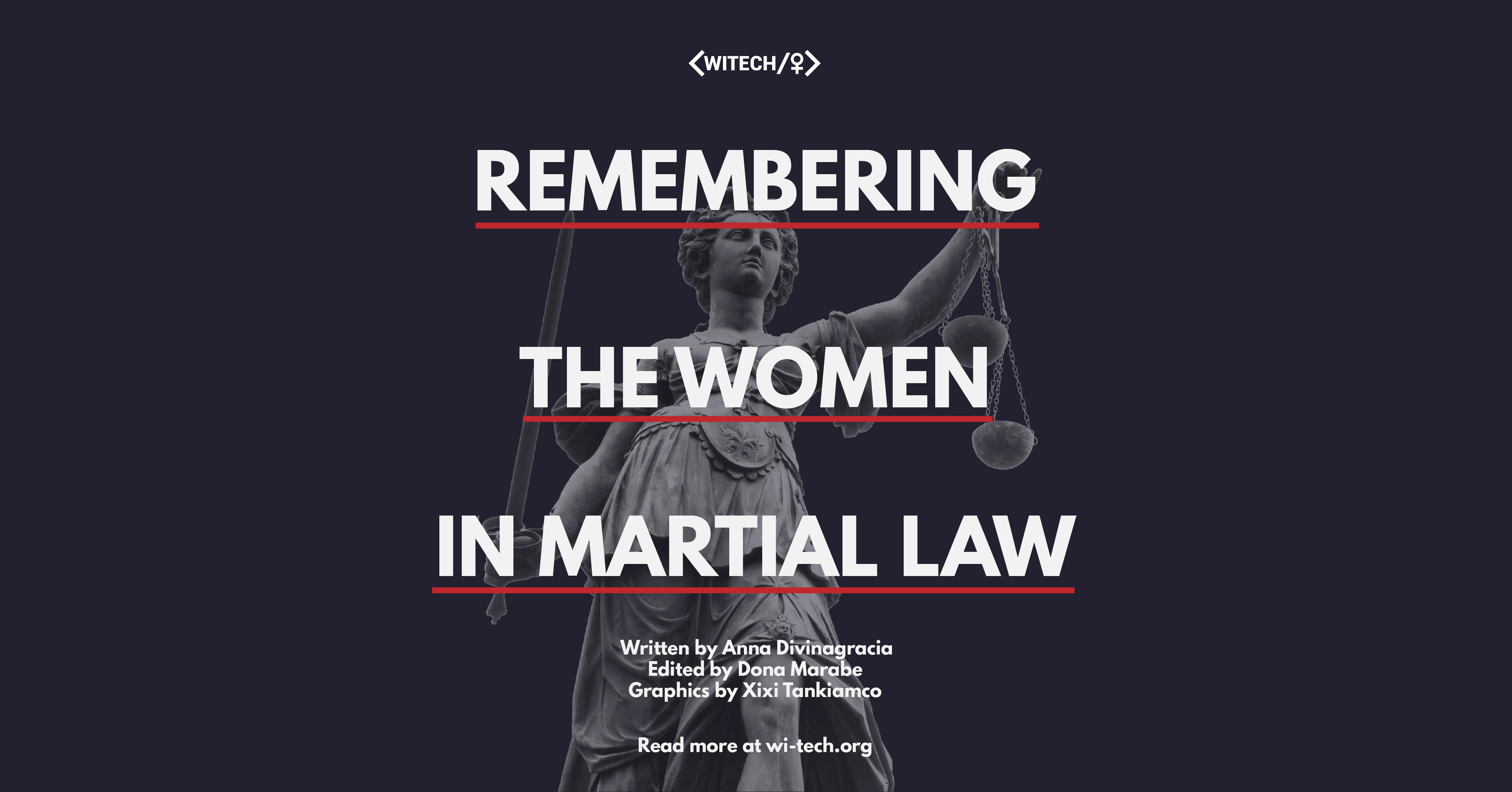Written by Anna Divinagracia
Edited by Dona Marabe
Graphics by Xixi Tankiamco
This article contains strong language, sexual content, graphic narratives, and other themes that may not be suitable for younger audiences. Kindly read at your own discretion.
What radicalized you? What experiences in your life made you think? Which moment changed you?
BOTTOM LINE UP FRONT!
- The stories of women in the Martial Law period, once an event memorized for a test, were stories that impacted the younger generation.
- Lilosa Hilao was the first female and student-activist to be killed in detention during the Marcos era. She used her skill in journalism to draft essays against the Marcos administration.
- Female victims of various torture methods would retell their stories amid their tears and anger in hopes of educating the younger generations to learn from the past.
- Maria Lorena “Lorrie” Barros founded MAKIBAKA, an all-female organization dedicated to initiating discourse among women on their role in politics, activism, and democratic struggle. Her motto: “The Filipino woman’s place is in the struggle.”
- We tell the stories of these unsung heroines, because we must never forget that we too must fight for our country and our freedom.
My story is that of another’s. Textbooks in elementary were rather filtered and refined to be more suitable for young audiences. Thus, descriptions of relatively gory events in Philippine history hardly told actual stories of war and were only carefully comprised of notable names, dates, and places to simply memorize.
The Martial Law period was no exception. Ferdinand Marcos and Benigno “Ninoy” Aquino Sr. were only names to be remembered for a test, the San Juanico Bridge was just the longest bridge in the country, and September 21, 1972 was simply when the then-President declared Proclamation 1081 — yet another random number most of us had to take note of. None of it mattered after the exam; Martial Law was finished long before I was born.
One month into high school changed that. Contrary to what elementary teachers told me, Ferdinand Marcos was not just another name I should have thrown out of my mind; neither was Imelda Marcos just some woman with a thousand shoes and bags. The Marcoses were suddenly rebranded in my mind as those who blatantly stepped on the rights of my people, the Filipino people, and conveniently got away with it.
That was not what radicalized me.
It’s no secret that women have been victims of harassment and sexualization since the beginning of time. Women constantly fear for their lives as they walk down the streets, night or day, as men shoot suggestive looks and unsolicited comments on how they walk, what they wear, and God knows what else. Women constantly look over their shoulders, watching out for knives ready to strike or hands aiming to reach.
The women in the Martial Law period had it no different, if not much worse. With military officers monitoring the people’s every move and Marcos’s cronies looking for entertainment, young women braced themselves for the worst – although, who could prepare for the worst when it looms right over you?
The stories of their pain, their suffering, and their rage radicalized me.
Trials worse than death: recounting terror
She was an honor student, expected to be cum laude upon graduation. Being a member of multiple student organizations, the communication arts student was also the passionate editor-in-chief of her university’s paper, HASIK. Although she was sickly, her prowess for the written word led her to composing several essays and articles against the Marcos administration. It wasn’t long until she was recognized as a student activist; it wasn’t long until she was found dead in detention, her body limp and with marks of torture all over.
Lilosa Hilao was the first female and student-activist to be killed in detention. Hers was a story cut short by the vicious hands. Hers was a story multiple women in the Marcos era shared – stories of trials worse than death.
As estimated by Amnesty International, 34,000 individuals were tortured in this harrowing era of the Philippines’s history. Victims, some alive to tell the tales and others subsequently killed in the process, bore the marks of torture on their bodies: burns, injection marks, bruises, and, more common in women, sexual abuse.
They will never be prepared to recount and relive the memories of their suffering. In front of the Supreme Court, Trinidad Herrera, an urban poor leader, bravely stood and recalled her share of electrocution in the Marcos era: wires were attached to her fingers, electrocuted until bleeding point, and were transferred to her nipples. Loretta Ann Rosales similarly testified in court, recounting her experience with torture by electric shock. Both these testimonies were provided to prevent the dictator’s burial in the Libingan ng mga Bayani – a feat that surprisingly failed.
Then-newlywed May Verzola-Rodriguez was arrested and repeatedly punched, slapped, and molested by her torturers. Luisa Posa recalled having been given the infamous “water cure,” wherein gallons of water would be forced into her mouth. She was subsequently subjected to the Russian roulette, whereby the barrel of a revolver would be loaded with one bullet, leaving the victim wondering by which shot she would die.
The weights of their immeasurable suffering would be written in history books. Yet, the emotions and senses in those moments of suffering would be ingrained in their minds forever, leaving the victims of Martial Law scarred beyond our imaginations.
“Maging mayaman ka, maging mahirap, basta taliwas sa kagustuhan ni Marcos ang iyong ginagawa, pwede kang mamatay.”
These are the words of Maria Cristina Bawagan, a political prisoner and torture survivor during the Martial Law period. Bawagan and fellow survivor Hilda Narciso recalled their past experiences in detention for the younger generations “to reveal the truth, to learn from the past, to have respect for human rights, and to be willing to sacrifice for this cause.”
An unsung heroine of heroines
True enough, the hundreds of student-activists in the Marcos era all sacrificed their lives for one cause: the freedom of the Filipino people from the clutches of the dictator. Without fear, young men and women would claim the streets as theirs, marching for Lady Justice. It was dangerous, but it was right.
Seeing life in poverty was what drove her to become one of those activists. At a young age, her thoughts were of the concerns of her fellowmen, bringing her deeper into activism. With discussions and demonstrations on political awakening, police brutality, and student organization, it was hard to turn a blind eye towards the amassing issues in the political climate.
It was then that she and other women started to discuss the role of women in politics, activism, and democratic struggle. She realized that establishing an all-female organization dedicated to initiating and engaging in discourse on women’s rights and involvement in social and political affairs would serve as a hallmark and an avenue to raise concerns and actively abolish the oppression against women. It was then that Maria Lorena Barros, or Lorrie as her friends called her, founded Malayang Kilusan ng Bagong Kababaihan (Free Movement of New Women), or MAKIBAKA.

MAKIBAKA was not your ordinary student organization. Lorrie’s organization articulated the oppression of women in all aspects and the need for women’s liberation through participation in nationalist struggle. While the men around her constantly reminded her that “a woman’s place is in the household,” Lorrie’s motto was one quite unlike expected: “The Filipino woman’s place is in the struggle.”
In the Philippine Martial Law era, Ferdinand Marcos suspended the writ of habeas corpus, therefore allowing warrantless arrests for “persons judicially charged for rebellion”. In the dictator’s handbook, Lorrie’s involvement as a student-activist in MAKIBAKA was a cause for concern; her strength limited his power. She, along with 62 other student leaders, were charged with subversion, causing her to flee to the countryside and join the New People’s Army to continue to aid in the national democratic movement.
Her strength brought her to an armed encounter in 1976, costing her life. She died an honorable death, with her beliefs and advocacies as aspirations, and her story as an inspiration for future generations. We tell her story to inspire others to do as she did: fight for just causes.
Never forget.
What radicalized you? What experiences in your life made you think? Which moment changed you?
The women in the Martial Law era suffered a great deal: torture, rape, death, rage, sorrow, and pain. Their stories remind us that erasing the past will erase their experiences – erase their rage, their sorrow, and their pain. Their stories remind us that 1972 isn’t just a random year, that Ferdinand Marcos wasn’t just a president of the Philippines, and that Martial Law isn’t just an event to be memorized for a test. These unsung heroines remind us that we should do better as citizens of our country – that we should be as brave as they were, regardless of our background, social status, or gender.
Our elementary textbooks, our friends, and even our family will silence us, because the stories of Martial Law are ‘too gory and grievous’; that’s what makes them bold. These stories should be told because of the mere fact that they are ‘too gory and grievous.’ These stories make us uncomfortable, these experiences make us enraged, and these moments make us realize that these stories were those of people fighting for their freedom; that should never be seen as something wrong.
For the 48th anniversary of the declaration of Martial Law, let us never forget the injustices against our fellow men and women, let us never forget the bravery of our fellow men and women, and let us never forget the fire that burns within us.
Retell their stories. Never forget.
REFERENCES
Hapal, D.K. (2016). Worse than death: Torture methods during martial law. Rappler. Retrieved from https://rappler.com/nation/torture-martial-law-marcos-regime
Olea, R.V. (2016). Martial law victims speak: ‘Do not forget our suffering’. Bulatlat. Retrieved from https://www.bulatlat.com/2016/08/31/martial-law-victims-speak-not-forget-suffering/
University of the Philippines Los Banos. (2019). Survivors recall Martial Law ordeal. Retrieved from https://uplb.edu.ph/campus/survivors-recall-martial-law-ordeal/
Ledesma, C.K. (2015). Women in revolution: Maria Lorena Barros and MAKIBAKA. National Democratic Front of the Philippines. Retrieved from https://ndfp.org/women-in-revolution-maria-lorena-barros-and-makibaka/

